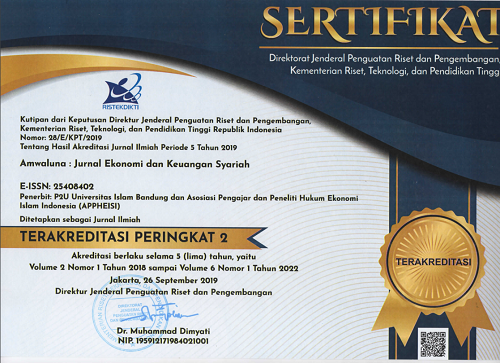Does Foreign Interest Rate Determine Islamic Stock Prices?
Abstract
This paper aims to investigate whether foreign interest rate determines Islamic stock prices vis-à-vis domestic interest rate. The method applied is the Autoregressive Distributed Lag (ARDL) model to Indonesian data from January 2008 to June 2018. The study found a long-run negative relationship between foreign interest rate with both Islamic and conventional stock prices. Additionally, foreign interest rate is more important than domestic interest rate in determining the price of both types of stocks. Although Islamic stocks are affected by foreign interest rate dynamics, they are less responsive to changes of the Libor than conventional equities. In addition, it is found that GDP, money supply and real exchange rate has a long-run positive relation with both stock price. Thus, although Islamic equity prices are not insulated against foreign interest rates, they are less responsive to international financial markets movements than conventional stocks. For policy, authorities should pay close attention to foreign interest rate dynamics. While policy makers and fund managers in a dual capital market can use Islamic stocks to provide cushion against dynamics of international funds market.
Keywords
Full Text:
PDFReferences
Abugri, B. A. (2008). Empirical relationship between macroeconomic volatility and stock returns: Evidence from Latin American markets. International Review of Financial Analysis. https://doi.org/10.1016/j.irfa.2006.09.002
Ajmi, A. N., Hammoudeh, S., Nguyen, D. K., & Sarafrazi, S. (2014). How strong are the causal relationships between Islamic stock markets and conventional financial systems? Evidence from linear and nonlinear tests. Journal of International Financial Markets, Institutions and Money. https://doi.org/10.1016/j.intfin.2013.11.004
Anaraki, N. K. (2019). Monetary Transmission Mechanism: Empirical Evidence from Eurozone. Journal of Finance and Economics, 7(3), 88–92. Retrieved from http://www.sciepub.com/JFE/abstract/10724
Asri, M., Ernawati, E., & Nusantara, A. W. (2021). The Effect of Knowledge and Regulation Toward the Islamic Financial Industry Development. Amwaluna: Jurnal Ekonomi Dan Keuangan Syariah, 5(2), 184-197. Retrieved from https://ejournal.unisba.ac.id/index.php/amwaluna/article/view/5950
Ayopo, B. A., Isola, L. A., & Olukayode, S. R. (2016). International Journal of Economics and Financial Issues Stock Market Response to Economic Growth and Interest Rate Volatility: Evidence from Nigeria. International Journal of Economics and Financial Issues, 6(1), 354–360. Retrieved from http:%0Awww.econjournals.com
Bahloul, S., Mroua, M., & Naifar, N. (2017). The impact of macroeconomic and conventional stock market variables on Islamic index returns under regime switching. Borsa Istanbul Review, 17(1), 62–74. https://doi.org/10.1016/j.bir.2016.09.003
Bekhet, H. A., & Matar, A. (2013). Co-integration and causality analysis between stock market prices and their determinates in Jordan. Economic Modelling. https://doi.org/10.1016/j.econmod.2013.07.012
Blokhin, A. (2019). Federal Funds Rate vs. LIBOR: What’s the Difference? Retrieved from Investopedia website: https://www.investopedia.com/ask/answers/072715/what-are-differences-between-federal-funds-rate-and-libor.asp
Boubakari, A., & Jin, D. (2010). The Role of Stock Market Development in Economic Growth: Evidence from Some Euronext Countries. International Journal of Financial Research. https://doi.org/10.5430/ijfr.v1n1p14
Chkili, W., & Nguyen, D. K. (2014). Exchange rate movements and stock market returns in a regime-switching environment: Evidence for BRICS countries. Research in International Business and Finance. https://doi.org/10.1016/j.ribaf.2013.11.007
Conti-Brown, P. (2018). Politics, Independence, and Retirees: Long-term Low Interest Rates at the Federal Reserve. In O. S. Mitchell, R. Clark, & R. Maurer (Eds.), How Persistent Low Returns Will Shape Saving and Retirement (pp. 11–25). Retrieved from https://books.google.co.id/books?hl=en&lr=&id=DJVqDwAAQBAJ&oi=fnd&pg=PA11&dq=Politics,+Independence,+and+Retirees:+Long-term+Low+Interest+Rates+at+the+Federal+Reserve.&ots=4YW0CnQy2s&sig=uko1vcHaOAoJFsmQ4kUAyBJoWRo&redir_esc=y#v=onepage&q=Politics%2C Independence%2C and Retirees%3A Long-term Low Interest Rates at the Federal Reserve.&f=false
Federal Reserve. (2023). Real Broad Effective Exchange Rate for Indonesia. Retrieved from Federal Reserve Economic Database website: https://fred.stlouisfed.org/series/RBIDBIS
Friedman, J., & Shachmurove, Y. (2017). Monetary Transmission: The Federal Fund Rate and the London Interbank Offered Rate (LIBOR). Journal of Finance and Economics, 5(1), 1–8. Retrieved from chrome-extension://efaidnbmnnnibpcajpcglclefindmkaj/https://www.researchgate.net/profile/Joseph-Friedman-2/publication/322093758_Published_by_Science_and_Education_Centre_of_North_America_Monetary_Transmission_The_Federal_Funds_Rate_and_the_London_Interbank_Offered_Rate_LIBOR/links/5a44450e0f7e9ba868a79e63/Published-by-Science-and-Education-Centre-of-North-America-Monetary-Transmission-The-Federal-Funds-Rate-and-the-London-Interbank-Offered-Rate-LIBOR.pdf
Hussin, M. Y., Fidlizan, M., Mohd Fauzi, A., & Awang, S. A. (2012). Macroeconomic Variables and Malaysian Islamic Stock Market : A Time Series Analysis. Journal of Business Studies Quarterly. Retrieved from chrome-extension://efaidnbmnnnibpcajpcglclefindmkaj/https://citeseerx.ist.psu.edu/document?repid=rep1&type=pdf&doi=01ef97539b649ea85bb3f9b5b25394f1c66724a7
Mai, M. U., Syarief, M. E., & Kristianingsih, K. (2021). Corporate Governance, Financial Leverage, and Performance of Sharia Manufacturing Companies on the Indonesia Stock Exchange. Amwaluna: Jurnal Ekonomi Dan Keuangan Syariah, 5(2), 255-272. Retrieved from https://ejournal.unisba.ac.id/index.php/amwaluna/article/view/7053
Majid, M. S. A., & Yusof, R. M. (2009). Long-run relationship between Islamic stock returns and macroeconomic variables: An application of the autoregressive distributed lag model. Humanomics. https://doi.org/10.1108/08288660910964193
Mustafa, S. A., Ramlee, R., & Kassim, S. (2017). Economic forces and Islamic stock market: Empirical evidence from Malaysia. Asian Journal of Business and Accounting, 10(1), 45–85. Retrieved from https://ajba.um.edu.my/index.php/AJBA/article/view/3475
OECD. (2023). Narrow money (M1). Retrieved from OECD database website: https://data.oecd.org/money/narrow-money-m1.htm
Osamwonyi, I. O., & Evbayiro-Osagie, E. I. (2012). The Relationship between Macroeconomic Variables and Stock Market Index in Nigeria. Journal of Economics. https://doi.org/10.1080/09765239.2012.11884953
Pan, L., & Mishra, V. (2018). Stock market development and economic growth: Empirical evidence from China. Economic Modelling. https://doi.org/10.1016/j.econmod.2017.07.005
Peiró, A. (2016). Stock prices and macroeconomic factors: Some European evidence. International Review of Economics and Finance, 41, 287–294. https://doi.org/10.1016/j.iref.2015.08.004
Pesaran, M. H., Shin, Y., & Smith, R. P. (1999). Pooled mean group estimation of dynamic heterogeneous panels. Journal of the American Statistical Association, 94(446), 621–634. Retrieved from https://www.tandfonline.com/doi/abs/10.1080/01621459.1999.10474156
Umar, Z., Shahzad, S. J. H., Ferrer, R., & Jareño, F. (2018). Does Shariah compliance make interest rate sensitivity of Islamic equities lower? An industry level analysis under different market states. Applied Economics, 50(42), 4500–4521. https://doi.org/10.1080/00036846.2018.1458191
DOI: https://doi.org/10.29313/amwaluna.v7i1.7001
Refbacks
- There are currently no refbacks.
Editorial Office:
Syariah Faculty, Universitas Islam Bandung
Jalan Tamansari No. 24-26 Kota Bandung

Amwaluna : Jurnal Ekonomi dan Keuangan Syariah is licensed under a Creative Commons Attribution-NonCommercial-ShareAlike 4.0 International License.








